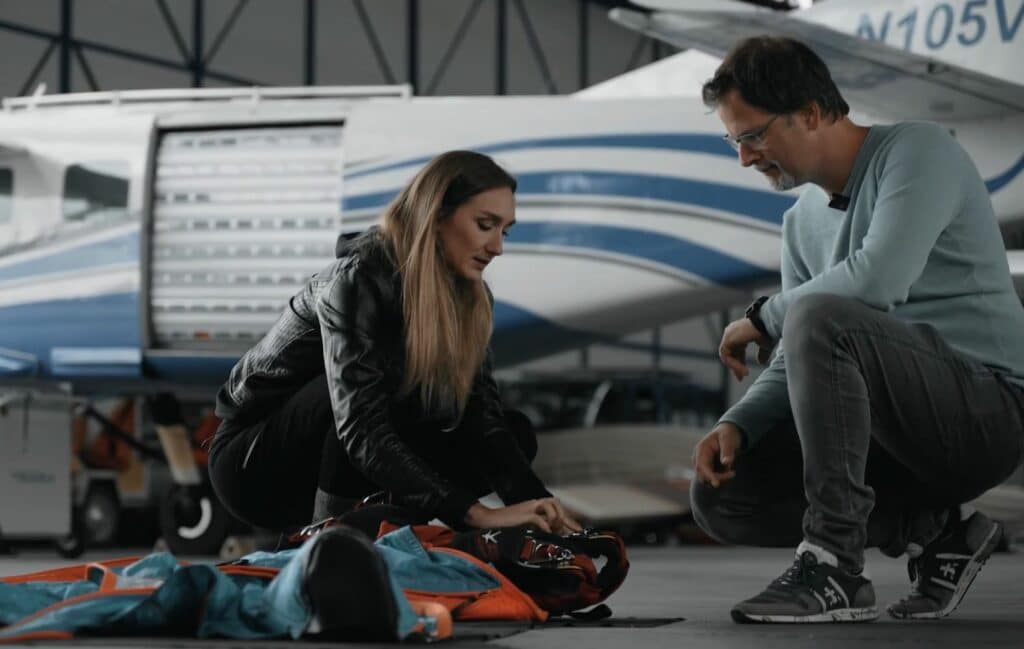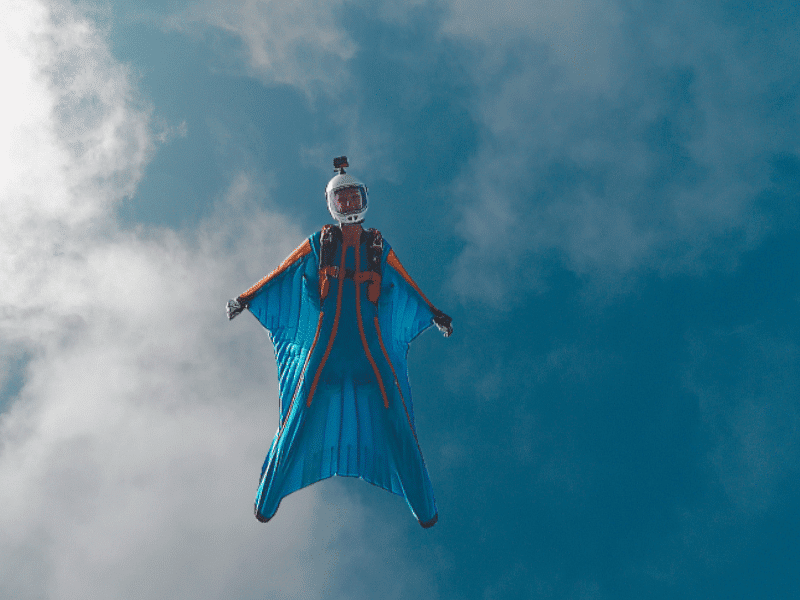What we can learn about risk from an extreme athlete
Lisa Buchner: Austria's first female wingsuit trainer
If there's anyone who knows all about risk, it's probably Lisa Buchner. The young sportswoman has dedicated herself entirely to her passion, wingsuit flying: she has been the first woman in Austria to teach this sport for over 5 years and has already completed countless jumps herself.
In our talk together in the flight hangar in Wels, she not only tells us about her understanding of risk, but also gives us insights into the functional and technical measurements she uses to better control risk.

Lisa, you've been a Winguit pro for several years now. How did this passion develop in you?
Even as a child, I always imagined that I wanted to fly away – it was always there, this fascination with flying. I used to run and jump away very quickly, and in my imagination I did “fly" for a short time. When I was 10, I got a hot air balloon ride for my birthday – but I always wanted to fly myself. Finally I found that feeling in skydiving and I love it.
What does “risk" mean to you?
Risk, for me, is uncertainty and lack of clarity. It's always the question mark in a given situation – what can happen – and the likelihood of it happening. I believe risk is highly individual because it has a lot to do with how one perceives situations. When people ask me why I jump out of airplanes, and isn't that extremely dangerous, I say: Yes, there is a certain risk involved, but actually, it's not as dangerous as one might imagine.
Would you say that you have a different understanding of risk than most people?
I don't think about risk when I jump. Just like when you get into a car, you probably don't think about the risk involved. You get in and think: where am I going today, or maybe you think: oh, I'm still pretty tired and then you somehow arrive at the office half asleep. You never think about the risk. And for me, skydiving has already become something that is almost an everyday occurrence.
How do you go about assessing the risks and how do you prepare for a jump?
You don't just go ahead and jump, you actually have a plan. You analyse the situation, you analyse the people you're jumping with, you analyse yourself and your equipment. You check your equipment before every jump day: Is everything in order? Are things where they should be, is nothing too worn?
Of course, you also check whether the weather is right – wind, for example, can be a problem. If it's too strong, you can't jump.
And rain?
Rain is no fun. You have to imagine you're flying at 200 km/h. And these raindrops are then very, very hard. So it's like a very, very strong peeling or you can even come out bloody with ice grains – you don't want that.
You mean, risk assessment is important?
Yes, absolutely! You really have to take a close look at everything and then consciously decide whether it’s safe or not safe enough. It actually takes a lot of courage to say: You might want to take the jump like this, but I’m out of it because it doesn’t feel right for me.

Have you had any dicey situations and how did you deal with them?
Yes, to be honest I don't know what happened, but I was in a flat spin*. To get out of it, it helps to have experience and to know what to do in such situations. But you also have to be able to call on this knowledge in this situation. In this case, I knew I had to form a ball with my body to get out of it, it's about taking the airflow away from the large area you have with a wingsuit – then it should theoretically fit again, and it did. It worked twice.
I now also know that I can deal with this situation – which is of course reassuring. Risk or dangerous situations are also good in themselves, because then you realise, you can handle it and can get out of it safely.
* In a flat spin, you start to rotate quickly around your own longitudinal axis and can no longer control your flight.

kmh
That's how fast you fly with the Wingsuit
metres above the ground
is the height at which the parachute should be pulled at the latest
jumps
Lisa has already completed (alone with the current measuring system)
Wie gewinnst du Erkenntnisse zum Risiko?
Da würde ich ganz stark auf die Erfahrung gehen, weil diese Erkenntnisse sammelt man mit Erfahrung, indem man Situationen selber erlebt oder davon hört. Es gibt Situationen, da kommt man von selber gar nicht drauf, weil sie so selten vorkommen – da kommt man erst darauf, wenn man sich mit anderen unterhält. Man muss schon seine Augen und Ohren immer offen halten und immer schauen, wo könnte was sein und wie kann ich das vermeiden, dass genau diese Gefahr eine Gefahr für mich selber oder für andere wird.
Also ich schaue mir alle Gegebenheiten ständig an. Beurteile Situationen die ganze Zeit neu. Behalte alles im Auge. Wenn das Wetter am Vormittag gut war, heißt es nicht, dass es am Nachmittag auch gut ist. Es ist ein stetiges Beobachten, Beurteilen und dann entscheiden: Was möchte ich machen? Was macht Sinn? Wie kann ich das Risiko minimieren?
What messages or advice would you like to pass on to young people who are interested in extreme sports or challenging adventures?
Well, my personal experience is that people are often afraid to do something: To go on a big trip or set off on something unknown or to start skydiving, to start wingsuiting. There's often a lot of fear and uncertainty at the beginning. But if you then talk to people who have already had the experience and who are perhaps really happy with it and successful and have already gained a lot of experience and knowledge, then I think it's a safe way to minimise the risk in the respective situation, have fun with the challenge and then master it successfully.
Thank you, dear Lisa, for the interesting conversation and “Blue Skies “*!
* Blue Skies" is an aviator's greeting in which one wishes for a “blue sky" and thus a successful jump.

Elmar Jilka, Founder of SEQiFY with Lisa Buchner
Watch the Expert Talk (German)
The conversation was conducted in German. The version to be read here is a translation.



